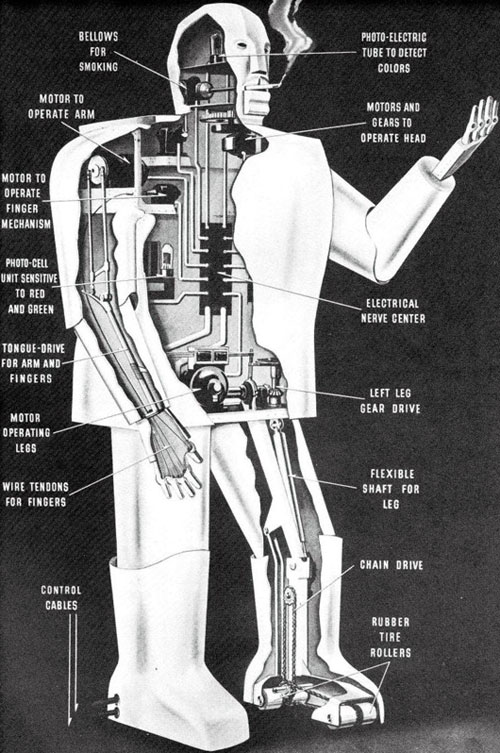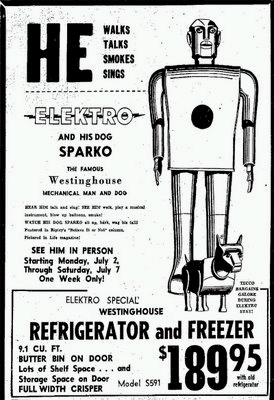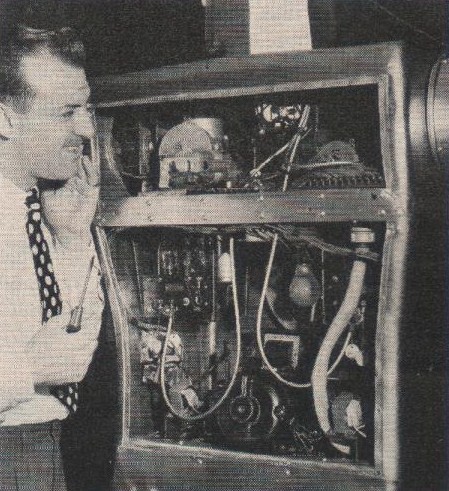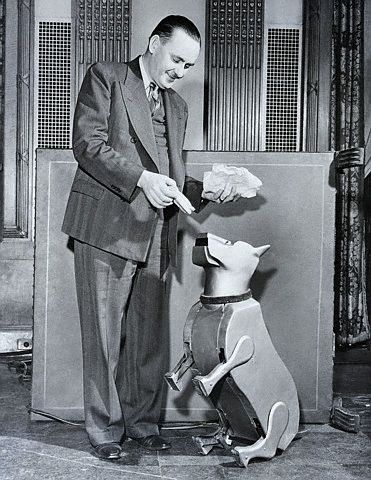I’ve always been fascinated by past visions of the future. Science fiction uses the future to tell us something about ourselves, so looking back on past visions of the future, we can learn something about that age and the values, myopia, optimism and fears of the time. It’s also healthy to continually do cross-checks on “how accurate was that prediction” and “what did we miss?” so that we can improve the accuracy of futuristic predictions over time.
Lost in the drama and bloodshed of the WWII age is the story of Elektro, the Smoking Robot.
In an era when we should have been much more focused on the rise of authoritarianism and threats to freedom, we human beings actually built, at great time and expense, a robot that could respond to basic voice commands, talk, distinguish red from green, do confined movements and smoke a cigarette.
Built by Westinghouse in Mansfield, Ohio, in 1937, Elektro was a 7-foot, 250-pound star of the 1939 World’s Fair. Elektro responded to voice commands of the operator, which did basic syllabic recognition. The chest cavity lit up as it recognized each word. Each word set up vibrations which were converted into electrical impulses, which in turn operated the relays controlling eleven motors. What mattered was how many impulses were sent by the operator, not what was actually said.
Check out this video to see a full demonstration of what Elektro could do, from The Middleton Family at the New York World’s Fair:
The Tin Man was to make his appearance on film that year, in the 1939 release The Wizard of Oz.
Meanwhile, across the Atlantic, Hitler was set to invade Poland. Alan Turing was off taking mathematics seminars by Wittgenstein in Cambridge, England. His Enigma decoding efforts had not yet begun. But those efforts would, within 3 years, help usher into existence the age of the computing and the programmable machine.
Elektro didn’t house any real software, aside from pre-recorded audio. He also didn’t learn anything — what Elektro could do was entirely predetermined by engineers through circuitry, relays and actuators.
Elektro could:
- “Recognize” basic spoken words — actually, just distinguish between the number of impulses
- Do basic audio output (via 78rpm record player)
- “Walk” and move his hands (thanks to nine motors)
- Recognize red or green
- …and of course, smoke
A series of words properly spaced selected the movement Elektro was to make. His fingers, arms and turntable for talking were operated by nine motors, while another small motor worked the bellows so the giant could smoke. The eleventh motor drove the four rubber rollers under each foot, enabling him to walk. He relied on a series of record players, photo voltaic cells, motors and telephone relays to carry out its actions. It was capable to perform 26 routines (movements), and a vocabulary of 700 words. Sentences were formulated by a series of 78 RPM record players connected to relay switches.
Elektro did his talking by means of recordings, thanks to 8 embedded turntables, each of which could be used to give 10-minute talks. Except for an opening talk of about a minute, his other speeches were only a few seconds long. A solenoid activated by electrical impulses in proportion to the harshness or softness of spoken words makes Elektro’s aluminum lips move in rhythm to his speech-making.

Millions stood in line for as many as three hours to watch Elektro during his 20-minute performances at the 1939-40 World’s Fair in New York City.
The hole in Elektro’s chest was deliberate, since Westinghouse wanted visual proof that no one was inside. As commands were spoken to him, one of two lightbulbs in his chest would flash, letting the operator know he was receiving the signals. He could turn his head side to side and up and down. He talked and his mouth opened and closed. His arms moved independently with articulated fingers.

He also smoked. An embedded bellows system let him puff on a cigarette, which was lit by his operators. Apparently, one of the operators trained to work Elektro (John Angel, shown below) used to smoke a pipe, but then quit when he saw how much buildup was in Elektro during the cleaning after each day.

Elektro was later joined by a robotic dog, Sparko:

After the World’s Fair, the two embarked on a cross-country journey. Apparently, a female companion was planned for Elektro, but when World War II broke out, aluminum was in short supply, Westinghouse was needed on many projects, and the plans to build one were cancelled.

